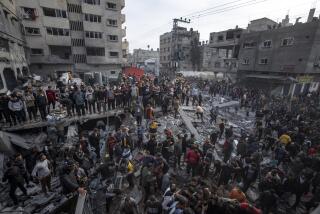U.S. probe finds 20 to 30 civilians may have been killed in Afghanistan battle
- Share via
KABUL, AFGHANISTAN — Disagreement over the civilian death toll in a battle this month in western Afghanistan sharpened Wednesday when the U.S. military estimated that 20 to 30 noncombatants were killed in the fighting. Afghan officials say 140 civilians were killed.
Civilian deaths have for months been a major source of friction between Western forces and their Afghan allies, and the incident in the village of Garani, in Farah province -- the deadliest of its kind since the U.S.-led invasion of 2001 if the Afghan figures are borne out -- has triggered a huge outcry here.
Underscoring the danger to civilians as the summer “fighting season” gets underway in earnest, the NATO-led force on Wednesday reported that eight civilians were killed in Helmand province a day earlier. As in Garani, the deaths occurred after Western-led forces called in airstrikes.
Helmand, adjacent to Farah, is a hot zone for the insurgency, and is where many soon-to-arrive American troops are expected to be deployed. Danger is increasing in other parts of the country as well. Near the capital, Kabul, a U.S. soldier and a contractor died in a roadside bombing Wednesday, the military said.
In addition to differing over the number of civilians killed in Garani, Afghan and American authorities have offered widely varying estimates of the number of insurgents slain in the fighting May 4. The preliminary U.S. investigation suggests that as many as 65 Taliban militants were killed. The Afghans’ number is considerably lower: about 25.
Wednesday’s statement, described as an interim finding, represented the first official U.S. estimate of the civilian toll in the fighting in Garani. Previously, U.S. officials had said the Afghan figure, which was compiled by a presidential commission, was high, but they had not offered one of their own.
“The investigation team estimates that 60 to 65 Taliban extremists were killed in these engagements, while at least 20 to 30 civilians may have been killed during the fighting,” the U.S. military statement says. The investigation by the U.S. Central Command is continuing, it says.
The only independent group to have reached the scene of the Garani fighting, the International Committee of the Red Cross, has said the dozens of dead included women and children.
Details about the Garani battle have been slow to emerge because of the village’s inaccessibility and the continued heavy presence of insurgents, who have a stronghold in the neighboring village of Shewan. Afghan security forces and even many locals consider the area a no-go zone, rife with banditry and ambushes.
The still-emerging picture points to a ferocious battle. On Monday, two weeks after the fighting took place, U.S. forces acknowledged that two 2,000-pound bombs and other explosives were dropped during a series of airstrikes around the village.
Afghan police and soldiers, backed up by U.S. Marines, had fought a daylong battle during which they were outnumbered by well-equipped Taliban forces, American officials have said in previous accounts.
Part of the dispute over the toll stems from the fact that relatively few bodies were left intact, according to villagers’ accounts. They said many people were torn apart by the blasts, in some cases reduced to unidentifiable scraps of flesh. Most of the structures in the village, including the compounds that were hit, are made of mud brick, which offers little protection against heavy weaponry.
The Afghan commission made its casualty count based on an on-site visit two days after the fighting, during which it inspected damage and fresh graves. It also relied on a list of names compiled by villagers. The Afghan government last week paid out compensation to the families of the dead after they provided certain information about their relatives, such as names and ages.
U.S. officials said Wednesday that aerial footage, which has not yet been released, showed that Taliban fighters were present in the buildings that were bombed.
“Investigators reviewed weapon-sight video . . . which clearly depicts insurgents entering the buildings which were then targeted in the final strikes of the fight,” the military statement said.
Villagers, however, have said there was a lull of at least 90 minutes before the final and most powerful airstrikes, and suggested that any detected movements would have been mainly caused by people fleeing the first of the blasts.
Residents said in interviews soon after the fighting that bombs hit two compounds where dozens of civilians were sheltering after hours of fighting earlier in the day. The U.S. military has not identified the targets other than to say they were two buildings that were the source of fire by insurgents.
--
More to Read
Sign up for Essential California
The most important California stories and recommendations in your inbox every morning.
You may occasionally receive promotional content from the Los Angeles Times.













